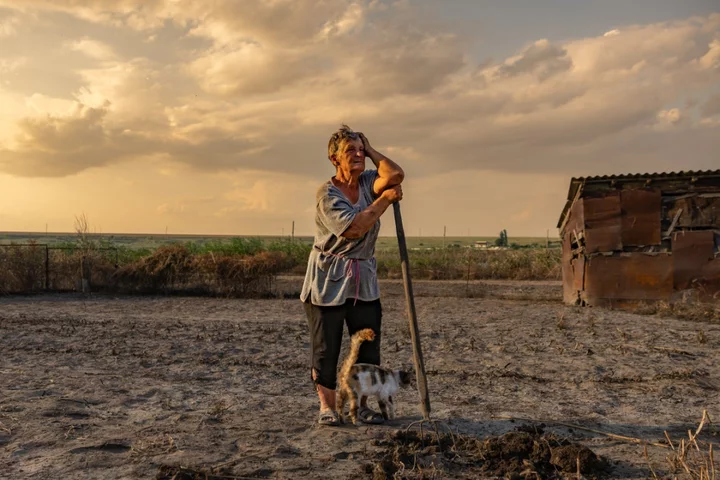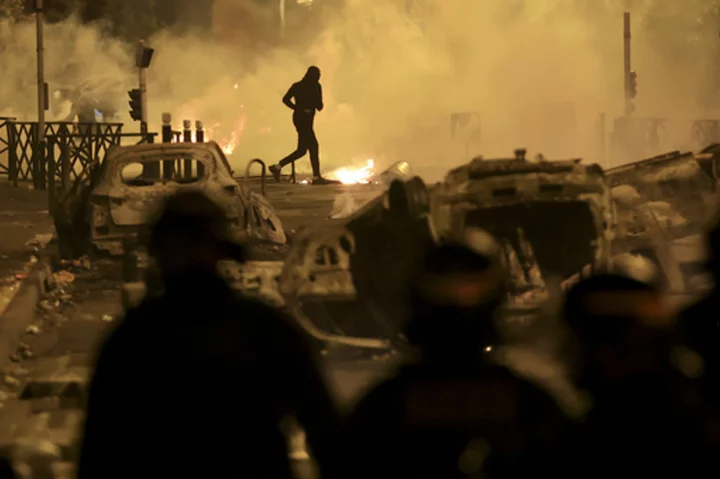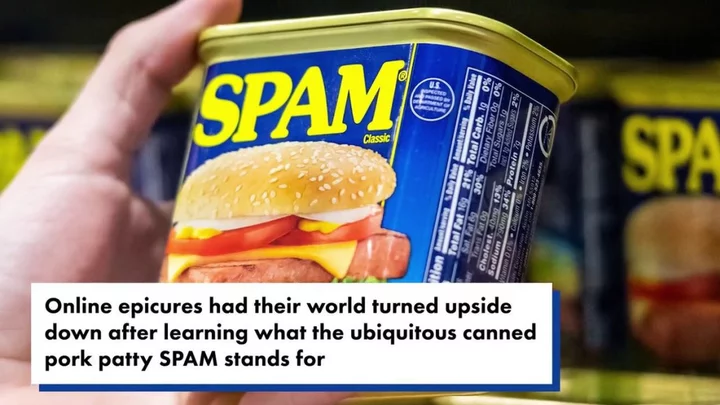
After the flood: The nightmare is just beginning for those left to rebuild after the Ukraine dam explosion
In a mud-soaked nightdress, the Ukrainian grandmother claws at the fetid water that has swallowed the steps down to her home in Kherson city. Frail and in shock, Antonia Shevchenko, 84 appears unaware of the futility of her attempts to try to drain the swamp drowning her house. Her daughter Svetlana, 64, marooned by the sweltering mud, tries to coax her to stop and calm down. Shelling roars in the background. It is the first time the pair have been back since they evacuated after the Nova Kakhokva dam blew up last month, unleashing the contents of one of Europe’s largest reservoirs over southern Ukraine. The explosion – which Ukraine blames on Russia – sparked the worst ecological disaster on the continent in recent history and will likely impact global food security, according to the United Nations. In Kherson, the capital of the region, it killed dozens of people, submerged whole towns, drowned all the wildlife and turned this street into a canal. “We didn’t even have time to get her clothes, we had to carry her in the slippers and nightie she is still wearing now,” says Svetlana in tears, as her confused mother repeats, “It’s all just mud,” in the background. “It’s impossible to fix this. I feel nothing now. Everything is just empty inside. Now it’s all gone, we have nothing left,” Svetlana adds. A few streets away Oksana Kuzminko, 70, who was also returning for the first time, picks her way through the devastation. “Welcome to zombie land,” she adds with a despairing shrug. Until recently, the only way to navigate these streets was to steer a boat between the tops of the roofs of the submerged houses. Now the waters have receded, the terrifying scale of the damage and the work still to be done has been revealed. Sewage, mud, rubbish, dead animals, bits of masonry and potentially land mines swirl together in the backyards of the partially collapsed houses. The area is still being pounded by Russian forces, stationed on the other side of the swollen banks of the Dnipro River. Anna Gatchecnko, 73, another elderly resident of this district, says the combination of floodwaters and the war is “your worst nightmare”. “We survived the Russian occupation, the shelling, and now this happened,” she says, wearing plastic bags she has tied to her feet in the toxic slush. “They took everything. My house, my belongings were the last things in this world that I had.” The Kakhovka dam – essential for fresh water and irrigation in southern Ukraine – is located in a part of the Kherson region that Moscow illegally annexed in September and has occupied for the past year. The damage is so severe that Ukraine has accused Russia of “ecocide” – believing Moscow’s forces blew it up in an attempt to prevent Kyiv’s troops from advancing in the south as they launched a counteroffensive. Moscow has vehemently denied the accusations and blamed Kyiv. Experts say the dam was so robustly built only an internal explosion could have caused such a catastrophic breach. The tearing floods have wiped out hundreds of towns and villages according to the United Nations, which has warned nearly a quarter of a million people have been left in need of drinking water. Downstream of the dam, towns and villages have morphed into polluted swamps where cholera has been detected. Upstream, the reservoir which once sustained swathes of agricultural land has turned into a salty desert. Residents in those areas queue to get water from fire trucks under shelling. And the repercussions will be felt well beyond Ukraine’s borders, potentially sparking global hunger. Ukraine – a major exporter of grains, oils and vegetables – was already struggling to export its harvest because of war. The ravages of flooding in one of the world’s most important breadbaskets will almost inevitably lead to lower grain exports, higher food prices around the world, and less to eat for millions in need. “The truth is this is only the beginning of seeing the consequences of this act,” Martin Griffiths, a United Nations aid official warned recently. It also raised fears about the stability of the Zaporizhzhia nuclear power plant, Europe’s largest, which relied on the waters of the now-dry Kakhovka reservoir to function. Rafael Grossi, head of the UN’s International Atomic Energy Agency which has unsuccessfully attempted to build a safety zone around the facility, was so concerned he travelled to the Russian-occupied plant. There he admitted it was ”grappling with ... water-related challenges”. In Zaporzhizhia’s regional capital, Taras Tyshchenko, head of the Ministry of Health’s Centre for Prevention and Disease Control, said if the Russians were capable of unleashing the waters over Kherson, they would have no qualms in taking out the nuclear power plant. Since the explosion at the dam, his health facility tests the air and waters across the region multiple times a day for radiation and contamination. So far it has detected cholera and remains on high alert for radiation. It has been through three rounds of training in the event there is a disaster at the nuclear power plant and has distributed potassium iodide tablets to those living within the danger zone. The damage from the destroyed dam is unfathomable, he says in front of the city’s main dock which is now dried out. The sweeping concrete jetty, which once hosted commercial water traffic, stoops forlornly over muddy puddles where his teams take water samples. “It could take well over a decade to fix the dam, refill the reservoirs and restore this region to normal,” he adds grimly. “And that work can only really start after victory.” In the interim, cities, towns and villages along the Kakhovka reservoir will morph into wastelands if no solution is found. Deep fissures criss-cross the cracked riverbeds where dead fish and molluscs slowly crisp in the sun. In one village, a forlorn fisherman drives a scooter across the desert scape in search of a pool of water. “Once the dam exploded we tried to build our own mini dams to try to retain some water,” explains Vitaly Marozov, 29, who works at a 400-hectare farm producing vegetables and fruit just outside of the southern city of Nikopol. He plays us a video of local volunteers building a makeshift barrier out of sacks and soil. “Now we are trying to dig wells but the water is salty,” he adds. This is already destroying crops. Standing by a destroyed field of cabbages, dusted white with salt, he says they will be lucky if they can salvage a fifth of their total yearly yield. The damage, he believes, will cost their farm 22 million hryvnias, or around £500,000, and it will only get worse as the season progresses. “We are just one farm, this is the case all around this area. This will impact global food security unless someone does something drastic,” he continues. Back in the waterlogged regions, volunteers deliver aid by boats to the communities now cut off from help. Others bring pumps to try to drain the pools of stagnant water from the worst-hit areas. But all it does is expose the irreparable damage done to the entire southern sweep of Ukraine. We find Olha Mosyk, 70, who was forced to swim to safety with a litter of newborn kittens, islanded by destruction in her home in the Mykolaiv region. Sodden muddy piles of dirt mark the remains of the walls of her house. “You need steel teeth to break Ukrainians. That won’t work on me,” she says, pulling up the remains of rotten potatoes from her destroyed field which is the same tyranny of blackened mud. “All we can do is try to pull ourselves together,” she adds with a pause. Back in Kherson city, Svetlana tries to comfort her mother, Antonia, who is on the cusp of a panic attack. “How do I feel? Crying all the time. My whole body is shaking,” the 84-year-old says faintly, her red floral nightie a flash of colour in the grey water. “It’s all flooded. My whole life is under water.” Read More Zelensky accuses Russia of plotting ‘radiation leak’ attack at Zaporizhzhia nuclear plant Ukraine's president tells other countries to act before Russia attacks nuclear plant Ukrainian soldiers rescue Russian troops left to drown after Kakhovka dam destruction Russia-Ukraine war live: Moscow ‘arrests General Armageddon’ over Wagner rebellion Recapping the revolt in Russia, through the words of 4 presidents and a mutinous warlord
2023-07-04 19:58

How tennis could be harming your body – and why it does you good
With Wimbledon underway and Nick Kyrgios already out due to injury, is tennis actually any good for you? Every tournament brings fresh injuries into the public eye, but the sport’s praises are often sung by fitness fans all over the world. So, how does it weigh up health and safety-wise? Is it worth investing some time in the sport if you enjoy Wimbledon? Tennis elbow The most common injury in tennis is tennis elbow, says Lucy Macdonald, physiotherapist at Octopus Clinic, and it’s something which has affected the likes of Andy Murray and Venus Williams. “Tennis elbow is the generic term for pain in the elbow, normally where irritation of the tendon runs over the elbow.,” she says. “It is often caused by a sudden overload on a tendon, in a way it is not used to, and it cannot cope with the forces that are on it. Treating it involves modifying what you are doing. “It can also be caused by other racket sports, and even things like breastfeeding a baby or cutting hedges and gardening,” she explains. But, it isn’t the end of tennis dreams. You can treat it. “Do not completely rest, modify the load going through the elbow, reduce the frequency and longevity of playing tennis, but things like physical support and tape can also help. “Changing your technique to take pressure off the tendon can help,” Macdonald explains. “The long-term treatment is to gradually build up the resilience of the tendon – a top spin stroke adds the most pressure – and alongside that, use static contractions – exercises that are just contracting the muscle, holding it and then relaxing.” Wrist injuries Kyrgios has pulled out of Wimbledon already, due to a wrist injury. “People may get wrist injuries if they fall and fracture the wrist. Or if they get a repetitive strain injury – if you use your wrist a lot in terms of the strokes you use with a lot of topspin – you can get some overuse and cause a flare up,” says Macdonald. Ankles and knees “Being on a slippery court, it can be easy to go over on your ankle,” she continues. “It happens in a lot of sports, if you’re running for a ball or trying to change direction. “You might get some knee problems, as they take such a hit generally with any propulsive sport – you get wear and tear on the knees, and sudden twists could impact your medial meniscus. Strength training is the best thing for that.” The benefits Should you be worried about all these injuries if you want to start playing, though? “The main cause of injuries in tennis is the sporadic nature people play it. If they suddenly go and play once every few months, the body is not used to the movements required in tennis, ” Macdonald notes.“You may suddenly run across the court and strain your calf or rupture your Achilles, because you haven’t run in months. “If you play it regularly and are consistent with the amount you play, it can be really beneficial,” she says.Any exercise is good, but the social aspect of tennis is hugely motivating, if you’re meeting up with three friends to play tennis, you have to show up – it gets you exercising regularly if you do it consistently. Tennis is beneficial for “increasing your heart and breathing rate, which is really good for your cardio and respiratory system. It keeps the range of motion in your shoulders, improves your balance with direction changes, and reduces your risk of falling,” says Macdonald. So, don’t let the risk of injury put you off. “There are so many positives that outweigh the negatives. Exercise, in general, extends your life span, and every illness out there is reduced by doing exercise. Even though it may have some impact on our musculoskeletal system, it is overwhelmingly positive for your mental and physical health.”
2023-07-04 19:51

Who is Jay Z's mother? Beyonce and Blue Ivy look resplendent as they attend Gloria Carter's wedding to Roxanne Wiltshire
Gloria Carter shares a strong bond with her son Jay-Z who was instrumental in bringing her out of the closet
2023-07-04 19:47

Have Heather Locklear's demons returned? Star has had major issues in the past with mental illness and substance abuse
Some of Locklear's friends told the publication that the actress may have started drinking again following several rehab stints
2023-07-04 18:58

'Liberty, equality, fraternity' for all? New riots make France confront an old problem
The lofty ideals of “Liberty, Equality, Fraternity" to which France aspires are embossed on its coins and carved above its school doors
2023-07-04 18:56

People are finally learning what SPAM actually stands for
Sandwiches have become increasingly elaborate creations: pillows of golden focaccia dripping with sumptuous pulled meats, tahini dressings, and spice-crusted roast veg. And yet, back in the day, you were lucky if you got a smear of margarine on yesterday’s white bread with a hunk of pink, pockmarked SPAM slammed unceremoniously in between. Ah yes, SPAM, there’s a reason why it became the butt of a Monty Python sketch and is now most commonly associated with the most annoying type of email correspondence. It’s unsexy, ultimately unhealthy and, at one point, was utterly unavoidable. Sign up for our free Indy100 weekly newsletter However, as we’ve established, food standards have somewhat evolved since WWII rationing so SPAM doesn’t get as much of a look-in at lunchtime these days. Still, most of us have at least heard of it even if we’ve never actually tried it. Monty Python - Spam youtu.be But now, people have suddenly realised that they don’t actually know what the acronym of its name stands for. Plenty of people have their own theories, though, which they’ve publicly shared on Twitter. “What does SPAM stand for? Salty Piece A' Meat?” one asked. “I often conjectured that 'Spam' was an acronym for 'Spoiled Ham',” wrote another. Another nodded to an old joke made by retired stand-up comedian Bill Endgvall: “I finally figured out what spam stands for – stuff posing as meat.” While another suggested it actually connotes “scientifically processed animal matter”. To clarify, SPAM itself is processed meat made of a pork and ham mixture, salt, sugar, potato starch, water, and sodium nitrite. The meat is ground and combined with the other ingredients before it is transferred to its signature rectangular can, vacuum-sealed, and cooked inside, the Encyclopedia Britannica notes. And despite the plethora of alternative suggestions, the name is, in fact, a portmanteau for spiced ham. It was coined in 1937 by its creator, New York actor Ken Daigneau, whose brother was an executive at the manufacturer Hormel Foods. According to Britannica, Daigneau later confessed that he’d come up with the name before he’d even conceived of the product, thinking it was memorable. Well, he sure hit the money on that one. SPAM continues to be loved by millions of households across the world, with more than 10 varieties of meat available on the market. Indeed, in Hawaii where it is perhaps best loved by consumers, it is enjoyed in a number of unique ways, including as an alternative to raw fish or egg in a sushi-style dish called musubi. And sure, we love our kimchi cauliflower milk rolls and slow-cooked lamb flatbreads but, credit where it’s due, SPAM has proven that it's the truly simple things that often stand the test of time. Have your say in our news democracy. Click the upvote icon at the top of the page to help raise this article through the indy100 rankings.
2023-07-04 18:53

Phoebe Waller-Bridge debating unpopular opinions with radio callers is a fun watch
Whenever a celebrity appears on BBC Radio One's "Unpopular Opinion" segment, there's always at least
2023-07-04 18:28

Ditch Deliveroo – make these healthy, 30-minute pizzas instead
Stop ordering pizzas on Uber Eats and get into the kitchen to make your own. These spicy feta, pepper and courgette pizzas from Cooks&Co will be hot and ready to eat long before a delivery driver gets there with your cold, soggy takeaway. Swap meat for vegetables and mozzarella for feta and you can call it a healthy win, too. Spicy feta, pepper and courgette pizzas Serves: 4 Prep time: 15 mins, plus defrosting | Cooking time: 12-15 mins Ingredients: 2 x 220g frozen pizza dough balls, defrosted 100g pizza sauce 200g grated mozzarella 1 courgette, cut into ribbons 150g Cooks&Co Roasted Red and Yellow Peppers, quartered 25g Cooks&Co Tri-colour Jalapeno Slices 100g feta To serve: Drizzle extra virgin olive oil Basil leaves Method: Preheat the oven to 240C/gas mark 9. On a floured surface, roll out each dough ball into a rough 30cm round and place on 2 large lightly floured baking trays. Spread with the pizza sauce leaving a 2cm border. Sprinkle with cheese and top with courgette ribbons, peppers and jalapenos. Crumble over the feta and drizzle with a little olive oil. Bake for 12-15 minutes. Drizzle with extra oil and scatter over a few basil leaves to serve. Cooks tip: Add spoonfuls of mascarpone instead of feta. For more recipes, visit cooksandco.co.uk Read More Three quick and easy vegan fakeaway recipes The dish that defines me: Eddie Huang’s Taiwanese beef noodle soup Nutritionist explains how women can eat to help balance hormones The only three recipes you need to seize the summer How to shop at Borough Market in the summer Budget Bites: Three light recipes that sing of summer
2023-07-04 18:23

Afghan Taliban order women's beauty parlours to shut
Afghanistan's Taliban authorities have ordered beauty parlours across the country to shut within a month, the vice ministry confirmed Tuesday, the latest curb to further...
2023-07-04 17:57

Sorry Netflix, Streamberry isn't funny
Now the dust has settled on Black Mirror Season 6, we're getting a sense of
2023-07-04 17:53

Everything you need to know about 'Insidious' ahead of 'The Red Door'
It's been five years since the last Insidious film was released, so horror fans are
2023-07-04 17:45

Major 2010s YouTubers announce they're pregnant with second child
Zoe Sugg and Alfie Deyes have announced that they're expecting their second child. The 2010s YouTube power couple announced the news with a sweet video featuring their one-year-old daughter, Ottilie, while holding up a scan photo. Sugg even displayed her blossoming baby bump, while the toddler gave her belly a peck. The 33-year-old revealed she is in her second trimester, and is expecting a little girl in a lengthier YouTube video. Sign up to our free Indy100 weekly newsletter
2023-07-04 17:17
